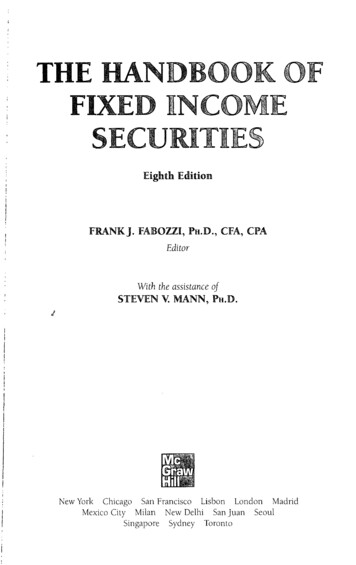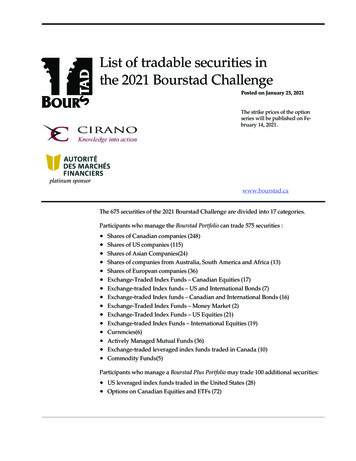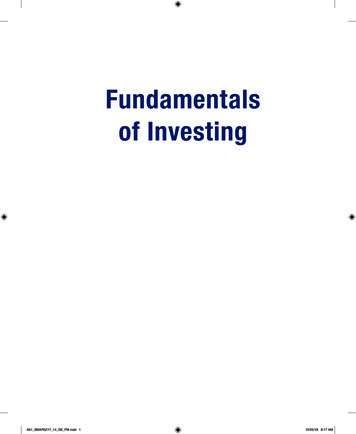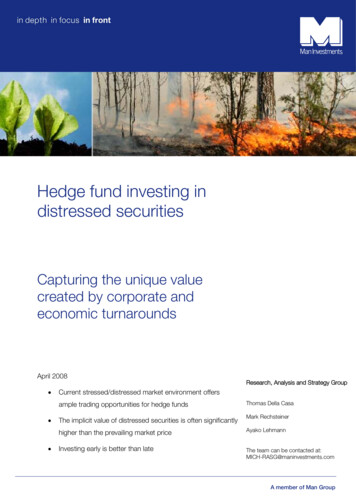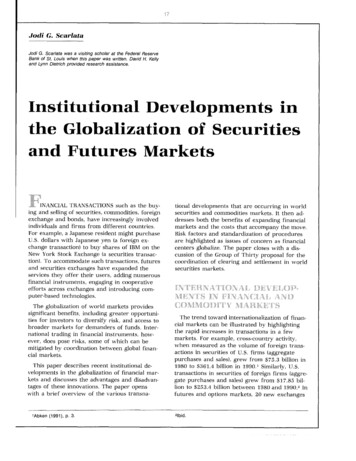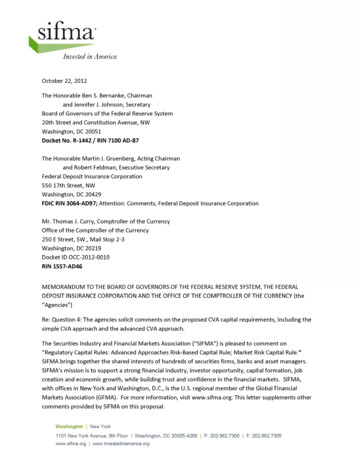
Transcription
sifmaInvested in AmericaOctober 22, 2012The Honorable Ben S. Bernanke, Chairmanand Jennifer J. Johnson, SecretaryBoard of Governors of the Federal Reserve System20th Street and Constitution Avenue, NWWashington, DC 20051Docket No. R-1442 / RIN 7100 AD-87The Honorable Martin J. Gruenberg, Acting Chairmanand Robert Feldman, Executive SecretaryFederal Deposit Insurance Corporation550 17th Street, NWWashington, DC 20429FDIC RIN 3064-AD97; Attention: Comments, Federal Deposit Insurance CorporationMr. Thomas J. Curry, Comptroller of the CurrencyOffice of the Comptroller of the Currency250 E Street, SW., Mail Stop 2-3Washington, DC 20219Docket ID OCC-2012-0010RIN 1557-AD46MEMORANDUM TO THE BOARD OF GOVERNORS OF THE FEDERAL RESERVE SYSTEM, THE FEDERALDEPOSIT INSURANCE CORPORATION AND THE OFFICE OF THE COMPTROLLER OF THE CURRENCY (the"Agencies")Re: Question 4: The agencies solicit comments on the proposed CVA capital requirements, including thesimple CVA approach and the advanced CVA approach.The Securities Industry and Financial Markets Association ("SIFMA") is pleased to comment on"Regulatory Capital Rules: Advanced Approaches Risk-Based Capital Rule; Market Risk Capital Rule."SIFMA brings together the shared interests of hundreds of securities firms, banks and asset managers.SIFMA's mission is to support a strong financial industry, investor opportunity, capital formation, jobcreation and economic growth, while building trust and confidence in the financial markets. SIFMA,with offices in New York and Washington, D.C., is the U.S. regional member of the Global FinancialMarkets Association (GFMA). For more information, visit www.sifma.org. This letter supplements othercomments provided by SIFMA on this proposal.Washington New York1101 New York Avenue, 8th Floor Washington, DC 20005-4269 P: 202.962.7300 F: 202.962.7305www.sifma.org www.investedinamerica.org
Page 2Background:In June 2012, t h e Agencies issued a joint notice of proposed rulemaking, "the Advanced ApproachesNPR," proposing t o revise t h e advanced approaches risk-based capital rule t o incorporate certainaspects of "Basel III: A Global Regulatory Framework f o r M o r e Resilient Banks and Banking Systems"(Basel III) t h a t t h e Agencies w o u l d apply only t o advanced approach banking organizations (referred t oherein as "Banks").On pages 17 and 23 of t h e Advanced Approaches NPR, t h e Agencies solicit comments on t h e proposedCVA capital requirements including t h e simple CVA approach and t h e advanced CVA approach. For t h ereasons described below, we believe t h a t t h e CVA capital requirement should not apply t o OTCderivative contracts w i t h US PSEs (as defined in t h e Agencies' notice of proposed rulemaking entitled"Regulatory Capital Rules: Regulatory Capital, Implementation of Basel III, M i n i m u m Regulatory CapitalRatios, Capital Adequacy, Transition Provisions, and Prompt Corrective Action") and United States-basednon-profit borrowers of tax-exempt bond proceeds 1 ("Non-Profit Borrowers" and together w i t h US PSEs,"Borrowers") w h e n such Borrowers execute OTC derivatives t o hedge or mitigate commercial riskrelated t o tax-exempt debt and energy purchase prices.Discussion:For more than 25 years, Borrowers in t h e municipal securities market have entered into swaps inconnection w i t h , or t o offset payment obligations on, related debt obligations, utilizing such swaps t ohedge or lower their borrowing costs on new, outstanding or anticipated debt. As a result of certainlimitations unique to t h e tax-exempt bond market, Borrowers w o u l d be disproportionatelydisadvantaged, relative t o other asset classes, by t h e CVA capital requirements as currently proposed.As set f o r t h in t h e Advanced Approaches NPR, Banks can mitigate CVA requirements by purchasingcredit default swaps ("CDS") 2 . The effectiveness of utilizing CDS t o mitigate CVA relies on t h e existenceof a robust and liquid CDS market. It is expected that, f o r many markets, this will be an effective t o o l forBanks t o reduce t h e impact of t h e CVA requirement. However, due t o structural and regulatoryconstraints unique t o t h e tax-exempt market, t h e CDS market for this asset class is illiquid and thinlytraded 3 . As a result, Banks will be unable t o purchase CDS in this market t o offset t h e CVA, resulting ininordinately high CVA capital allocated t o this particular market.W e f u r t h e r note t h a t these structural and regulatory constraints, unique t o t h e tax-exempt market,make it unlikely t h a t a robust market in related CDS will develop in t h e foreseeable future, even givent h e potential increased appetite for such products among Banks seeking t o reduce their CVArequirements, as tax considerations related t o t h e allocation of tax-exemption interfere w i t h t h e ability1Such borrowers typically include non-profit healthcare institutions, non-profit higher educational institutions and other similarnon-profit organizations.2See Section II.A.4 of the Advanced Approaches NPR.See Nicole Bullock and Aline van Duyne, "Hedge funds go in search for way to short munis," Financial Times, February 8, 2011;Dan Seymour, "Hedging Munis: It Ain't Easy," The Bond Buyer, July 22, 2010; Cate Long, "There is no municipal CDS market,"Reuters, January 12, 2012.3
Page 3t o "short-sell" tax-exempt debt on a regular basis. 4 Furthermore, t h e non-bank institutional investorsw h o are familiar w i t h municipal credit and w o u l d be t h e natural sellers of protection t o Banks via CDS,and have w a n t e d t o sell CDS, have been unable t o do so because t h e tax-exempt nature of their bondfunds creates a disincentive for t h e m t o receive t h e taxable interest income stream t h a t w o u l d becreated by such transactions.Although t h e proposed rules w o u l d also allow Banks t o offset, t o a lesser degree, CVA by holdingcollateral posted by counterparties, most Borrowers, while highly credit-worthy, w o u l d not be in aposition t o post collateral at levels required t o significantly impact t h e related capital charges. US PSEsgenerally do not carry large cash balances, thereby minimizing taxes, and Borrowers borrowing on a"revenue" basis are also similarly frequently constrained in t h e size of their cash balances, as theirfinancing structures typically, by design, produce limited amounts of excess cash. For some US PSEs, t h eposting of collateral w o u l d be prohibited by law 5 and f o r many Borrowers, t h e posting of collateral issubject t o t h e limitations of pre-existing indenture or credit agreement lien covenants.The factors described above, unique t o t h e tax-exempt debt market, will result in untenable capitalrequirements for CVA generated by swaps w i t h Borrowers t h a t do not reflect t h e t r u e economic risk oft h e transactions as demonstrated by t h e last 25 years. The cost of such capital will necessarily be borneby those Borrowers and may even be prohibitive, interfering w i t h Borrowers' ability t o effectively hedgeexposures and manage their risk.Summary:The Agencies should exempt derivative transactions w i t h Borrowers f r o m both t h e standard andadvanced approach CVA methods. Excluding derivative transactions w i t h Borrowers w h o are hedging ormitigating commercial risk related t o tax-exempt debt and energy purchase prices w o u l d avoid t h eunintended consequences described above and serve t h e best interests of Borrowers.W e note, as a related matter, t h a t European lawmakers, in their efforts t o incorporate t h e Basel IIIterms into t h e European Union's regulations, are considering various proposals t o exclude transactionsw i t h certain counterparties f r o m t h e CVA capital requirements, including a proposal t o excludetransactions w i t h "non-financial counterparties" under certain circumstances 6 . Any disparity betweenUS and EU regulations on this point could put US Banks at a significant competitive disadvantage.4Ibid.See State ex rel Kane v. Goldschmidt, 308 Ore. 573 (discussing the creation of debt within the meaning of Or. Const. art XI, §7); See also Brown v. City of Stuttgart, 312 Ark. 97 (discussing the creation of debt within the meaning of Ark. Const., art. 16 §1).56Matt Cameron, "New CRD IV draft exempts sovereign trades from CVA capital charge," Risk.net, March 6, 2012.
Page 4W e appreciate t h e o p p o r t u n i t y t o provide t h e Agencies w i t h these comments. If you have any questionsor wish to discuss t h e above comments further, please do not hesitate t o contact us.Sincerely,Michael DeckerManaging Director and Co-Head of Municipal Securities
sifmaInvested in AmericaOctober 22, 2012The Honorable Ben S. Bernanke, ChairmanBoard of Governors of the Federal Reserve System20 th Street and Constitution Avenue, NWWashington, DC 20051Docket No. R-1430 / RIN 7100-AD87The Honorable Martin J. Gruenberg, Acting ChairmanFederal Deposit Insurance Corporation550 17 th Street, NWWashington, DC 20429RIN 3064-AD95; Attention: Comments, Federal Deposit Insurance CorporationMr. Thomas J. Curry, Comptroller of the CurrencyOffice of the Comptroller of the Currency250 E Street, SW., Mail Stop 2.3Washington, DC 20219Docket ID 0CC-2012-0008MEMORANDUM TO THE BOARD OF GOVERNORS OF THE FEDERAL RESERVE SYSTEM, THE FEDERALDEPOSIT INSURANCE CORPORATION AND THE OFFICE OF THE COMPTROLLER OF THE CURRENCY (the"Agencies")Re: Treatment of Unrealized Gains and Losses on US Municipal Debt SecuritiesThe Securities Industry and Financial Markets Association ("SIFMA") is pleased to comment on"Regulatory Capital Rules: Regulatory Capital, Implementation of Basel III, Minimum Regulatory CapitalRatios, Capital Adequacy, Transition Provisions, and Prompt Corrective Action." SIFMA brings togetherthe shared interests of hundreds of securities firms, banks and asset managers. SIFMA's mission is tosupport a strong financial industry, investor opportunity, capital formation, job creation and economicgrowth, while building trust and confidence in the financial markets. SIFMA, with offices in New Yorkand Washington, D.C., is the U.S. regional member of the Global Financial Markets Association (GFMA).For more information, visit www.sifma.org. This letter supplements other comments provided by SIFMAon this proposal.Washington New York1101 New York Avenue, 8th Floor Washington, DC 20005-4269 P: 202.962.7300 F: 202.962.7305www.sifma.org www.investedinamerica.org
Page 2I.IntroductionIn June 2012, t h e Agencies issued t h e j o i n t notice of proposed rulemaking ("NPR") listed above, t h a tw o u l d revise their risk-based and leverage capital requirements consistent w i t h agreements reached byt h e Basel Committee on Banking Supervision ("BCBS") in "Basel III: A Global Regulatory Framework forM o r e Resilient Banks." This letter will address t h e NPR in regard t o U.S. municipal debt securities,described by t h e Agencies in t h e Standardized Approach proposed rule as either "General Obligations"or "Revenue Obligations" of Public Sector Entities ("PSE"), which t h e Agencies have defined t o include astate, county, city, t o w n or other municipal corporation, a public authority, and generally any publiclyo w n e d entity t h a t is an instrument of a state or municipal corporation. In t h e NPR and t h ecorresponding Proposed Rule (released on August 30, 2012), t h e Agencies discuss t h e "Treatment ofUnrealized Gains and Losses of Certain Debt Securities in Common Equity Tier 1 Capital" and go on t omention U.S. municipal debt securities ("US PSE Debt"), stating:"The agencies also seek commentby states or other politicalthough unrealizedon whethersubdivisionsunrealizedof the United States should receive similar treatment,gains and losses on these obligationsrisk and not primarilyfrom fluctuationsgains and losses on general obligationsin a benchmarkissuedevenare more likely to result from changes in creditinterestrate."W e respectfully disagree w i t h t h e Agencies t h a t valuation changes in such securities are " m o r e likely t oresult f r o m changes in credit risk and not primarily f r o m fluctuations in a benchmark interest rate." Tot h e contrary, one hundred years of data demonstrate t h a t valuation changes in municipal debtsecurities are primarily driven by fluctuations in benchmark interest rates, and not changes in credit risk.If t h e Agencies conclude t h a t Accumulated Other Comprehensive Income ("AOCI") associated w i t h USGovernment Debt Obligations (i.e., U.S. Treasury Securities) should be excluded f r o m Common EquityTier 1 Capital ("CET1"), t h e n both U.S. PSE General Obligation Debt and U.S. PSE Revenue Debt w i t hcertain credit characteristics should receive t h e same t r e a t m e n t . The Investment Grade definition,contained in Title 12 Code-of-Federal-Regulations 1 ("CFR") Part 1, which w e r e recently updated in ordert o meet t h e ratings removal requirements of Section 939A of t h e Dodd-Frank Act, and relied upon byt h e Agencies t o bifurcate corporate exposures in t h e June 2012 j o i n t final rule covering "Risk-BasedCapital Guidelines: Market Risk", should be used t o define t h e US PSE Debt t h a t should be eligible t ohave AOCI excluded f r o m CET1. The Agencies could f u r t h e r narrow t h e universe of eligible US PSE Debtf o r this purpose ( w i t h o u t regard t o w h e t h e r General Obligation or Revenue Obligation) by subdividingt h e revised Investment Grade definition, w i t h t h e strongest credits being defined as Very High Quality("VHQ"), and only allowing AOCI exclusion f r o m CET1 for US PSE debt which met t h e VHQ designation(see Appendix A).Symmetrical t r e a t m e n t for t h e exclusion of AOCI on CET1 for Government Obligations and VHQMunicipal Bonds is warranted in consideration of t h e following:1Department of Treasury, Office of the Comptroller of Currency Docket ID O C C - 2 0 1 2 - 0 0 0 5 . June 2012 Final Rule.
Page 3A)Valuation changes on VHQ Municipal Bonds move in line w i t h valuation changes on municipalbonds t h a t have been legally defeased w i t h US Government Obligations (Treasury Securities orSLGS2), which are referred t o as PreRefunded ("PreRe") Municipal Bonds. Both t h e market andt h e Code of Federal Regulations make clear t h a t PreRe Municipal Bonds are treated as USGovernment risk and not t h e risk of t h e municipal issuer. Therefore, if no material spread basisexists between PreRe Municipal Bonds and other VHQ Municipal Bonds, one can infer t h a t anybasis t h a t does arise between VHQ Municipal Bonds and on-the-run US Treasuries is not creditrisk related.B)VHQ Municipal Revenue Obligation Bonds demonstrate no material price/valuation deviationsf r o m VHQ Municipal General Obligation Bonds. The Agencies should not make any distinctionbased on Revenue Obligation pledge vs. General Obligation pledge. The distinction should bebased on credit quality, as it appears t h e Agencies intend t o prevent credit driven valuationchanges f r o m being filtered f r o m CET1. During t h e 2008 credit crisis, f o r example, VHQMunicipal Revenue Obligation Bonds displayed less spread variation t o VHQ Municipal GeneralObligation Bonds t h a n t h e spread variation observed between various off-the-run TreasuryNotes and Treasury Bonds of similar maturity.C)Federal Reserve H.15 data shows t h a t during financial stress of t h e 1930's and 1970's, valuationchanges on VHQ Municipal Bonds were similar t o t h a t of US Government Debt Obligations.D)Despite attempts t o sensationalize U.S. Public Sector credit issues in t h e popular media, over t h epast 100 years t h e realized credit losses on all municipal debt has been less than 1%. Given t h a tthere are over 78,000 unique US PSE entities, even if one US PSE filed bankruptcy every day f o rt h e next year; t h a t w o u l d represent a 0.5% annual default rate. Although today's creditevaluation methods cannot be applied t o t h e past 100 years, if w e use available NRSRO ratings,which was market practice f r o m t h e 1920's t o 2010, there is no available evidence t h a t a VHQMunicipal Bond ever defaulted.E)As recently noted 3 by staff of t h e Federal Reserve Bank of New York, defaults on US PSE debtt h a t w o u l d meet t h e Type I and Investment Grade definition are extraordinarily rare. From 1970through 2011, t h e 41-year cumulative total percentage of defaulting US PSE Obligors whichw o u l d generally meet t h e Type I and Investment Grade definition was less than a quarter of onepercent.Supporting evidence for t h e first four statements is contained in exhibits A, B, C, and D, respectively.W e support t h e desire t o align CET1 w i t h Tangible Common Equity ("TCE"); however, we do not believethis should be achieved by inhibiting municipal government access t o bank financing relative t o Federal2SLGs are State and Local Government Series (Federal Regulations ("CFR") Title 31, Part 344). SLGs are non-marketable U.S.Government Obligations used primarily for creating escrows to legally defease the principal and interest of Municipal BondObligations.3Jason Appleson, Eric Parsons, and Andrew Haughwout, "The Untold Story of Municipal Bond Defaults," Federal Reserve Bank ofNew York, August 2012.
Page 4government access t o bank financing, as both Federal and municipal entities govern and serve publictaxpayers. Public policy and national interests, implemented at both t h e Federal and local level via debtfinancing, benefit t h e United States of America as a whole, and finance investment in such importantareas as elementary schools, preference for home-ownership, military spending, bridges, water deliverysystems, roads and subways, among others. Municipal Bonds issued t o finance these national objectivesshould receive t h e same AOCI exclusion f r o m CET1.Individual State laws require t h a t public sector deposit monies held at banks in excess of t h e FDICinsured a m o u n t be collateralized w i t h either U.S. Municipal Securities or US Government Obligations.According t o Federal Flow of Funds data, State & Local Governments had 409bn of deposits on June 30,2012. The ability of a bank t o take and collateralize these public sector deposits will be damaged if AOCIassociated w i t h Municipal and Government Securities impacts CET1, as t h e additional regulatory capitalrequired t o support t h e Security position will likely make t h e business untenable f r o m a regulatorycapital perspective.Even if t h e f u t u r e is different f r o m t h e past 100 years, and t h e default rate on PSE debt increasesmaterially, PSE debt will not lead t o widespread U.S. banking problems like t h e ones caused by bad realestate debt during t h e savings and loan 4 crisis or t h e broader financial crisis of 2008. Banks do not holdenough U.S. PSE debt, nor is t h e r e enough in existence, t o lead t o similar banking system losses. USdeposit institutions currently hold 4 trillion of non-GSE mortgages 5 vs. 0.3 trillion of US PSE debt, andUS tax law discourages banks f r o m holding most state and local government debt. Since 1952 (earliestFed data available), US Banks have held on average t e n times t h e a m o u n t of non-GSE real estate backedmortgage debt t h a n US PSE debt.Additionally, consistency should be desired for t h e t r e a t m e n t of US PSE Debt w i t h i n t h e US Agency BaselIII Standard Approach NPR, t h e US Agency Basel III Advanced Approach NPR and t h e pending US Agencyrelease on t h e Basel III Liquidity Coverage Ratio NPR. Ultimately, t h e US Agencies should harmonize t h estandard risk-weights, LCR eligibility and AOCI exclusion f r o m CET1 for US Debt classes. For instance, allVHQ Municipal Bonds should be eligible for a 20% risk-weight under t h e standard approach,symmetrical AOCI t r e a t m e n t w i t h US Government Obligations and eligible as liquid collateral for LCRpurposes.Depending on t h e views of other interested parties, such as foreign governments, state and localgovernments, and other industry groups, t h e Agencies should consider excluding AOCI f r o m CET1 for alldebt instruments which meet t h e Type I Security definition as contained in 12 CFR Part § 1.2.Delineating debt securities at t h e OCC definition of "Type I", for this purpose, w o u l d align w i t h USCongressional preference demonstrated by public laws 73-66 and 106-102, which w e r e implemented via12 U.S.C. 24 (Seventh).45Former FDIC and RTC chairman William Seidman, "History of the 1980's, Lessons for the Future"Federal Reserve statistical release, Flow of Funds Accounts of the United States.
Page 5W e appreciate t h e o p p o r t u n i t y t o provide t h e Agencies w i t h these comments. If you have any questionsor wish to discuss t h e above comments further, please do not hesitate t o contact us.Sincerely,Michael DeckerManaging Director and Co-Head of Municipal Securities
Page 6EXHIBITa.CValuation changes on V H Q Municipal Bonds are predominantly attributable to changes inbenchmark interest rates and supply vs. demand factors, and not from changes in credit risk."The agencies seek commenton alternativesto the proposedon AFS securities, includingan approachwhose valuationschange as a result of fluctuationsprimarilyexcluded from a banking organization'streatmentof unrealizedgains and losseswhere the unrealized gains and losses related to debtregulatoryin a benchmarksecuritiesinterest rate would becapital"Valuation changes on VHQ Municipal Bonds generally follow t h e direction of Treasury Yields (presumedt o be Benchmark Interest Rates), except during rapid de-levering periods, such as late 2008 and early2009. However, these brief distensions are driven by liquidity contractions and not because of aperceived change in t h e Credit Risk of VHQ Municipal Bonds. This same phenomenon can be observedin t h e Treasury Market, where off-the-run treasuries widened t o on-the-run treasuries and w h e r e lessliquid US Government Guaranteed paper, such as Israel AID Bonds, widened even further.VHQ Municipal Bonds do at times exhibit price and yield volatility versus t h e Treasury Yield Curve(assuming this is w h a t t h e Agencies meant w h e n describing "benchmark interest rates"); however, it iseasily proven t h a t this volatility does not come f r o m credit risk, as t h e yields on PreRefunded (USGovernment Obligation risk and 0% risk weight) municipal bonds tracked yields on VHQ MunicipalBonds. Below is a comparison of three debt instruments: US Treasury Bond due 11/15/2021, CUSIP 912810EL8 North Carolina Eastern Municipal Power Agency ("NCEMPA") CUSIP 658196GA2, legallydefeased w i t h US Treasury Collateral in 2003 t o a maturity date of January 1, 2022 5.0' V General Obligation Bond of t h e State of Delaware due 3 / 1 / 2 0 2 2 NMn Aêh.A A.' VfisVi V-iAitllItA A. / JlJ » I k irtn J WWH\r \rUUm12.5Jan-07—Jul-07Jan-08Jul-08US Treasury Bond due 11/15/21Jan-09Jul-09Jan-10 N C E M P A Pre Re due 1/1/22,i" j i -ji ,0V viW.Jul-10Jan-11Jul-11Delaware G.O. B o n d due 3/1/22
Page 7The chart shows t h a t t h e Delaware General Obligation Bond moves in line w i t h t h e PreRe NCEMPABond. Over t h e five-year horizon shown above, t h e average yield on t h e Treasury Bond was 3.81%, t h eaverage yield on PreRe NCEMPA bond 3.59% and on t h e Delaware State General Obligation Bond 3.55%.During t h e 4Q of 2008 both t h e NCEMPA PreRe and t h e Delaware G.O. Bond lagged t h e rally in treasuryrates, however t h e Delaware G.O. Bond did not materially deviate f r o m t h e NCEMPA PreRe. The reasonf o r t h e very brief distension between VHQ Municipal Bonds and US Government Bonds was not creditrelated; it was caused by t h e rapid reduction of financial leverage which existed globally during t h em o n t h of December 2008.Furthermore, this same phenomenon was observable in US Government Obligations (shown below), as20-year old Treasury Bonds widened by 75bp versus just-off-the-run 10-year Treasury notes of t h e samematurity.807060 ncoÛ.50 -10Jul-10Jan-11Jul-11Very Old Treasury Bonds vs. Old Ten-Year Notes (matching maturity dates)Under t h e present monetary arrangement (non convertible free floating currency), US Governmentobligations have no default risk (except for intentional repudiation or Congressional failure t o raise t h eDebt Limit). Therefore, credit risk could not be t h e cause of an 80bps spread widening between USGovernment Obligations w i t h t h e same final maturity, but differing dates of issue. The differentialbetween like-maturity Government Obligations represents a liquidity preference, not a credit concern.The market has demonstrated this, as pre-2008 t h e spread was less than 10bps, and after going up t o80bps in 2008, has presently returned t o 10bps. The same liquidity phenomenon explains t h e distensionof both VHQ Municipal Bonds and pre-re municipal bonds versus on-the-run Treasuries during 2008.Neither very old Treasury Securities nor VHQ Municipal Bonds deviated f r o m on-the-run treasuriesbecause of "credit risk" they both deviated because of acute liquidity contractions.
Page 8EXHIBITb.CValuation changes on V H Q Revenue Obligation Bonds are the same as valuation changes onVHQ General Obligation Bonds.VHQ Municipal Revenue Bonds demonstrate no material price/valuation deviations f r o m VHQ MunicipalGeneral Obligation Bonds. For purposes of AOCI, t h e Agencies should not make their distinction basedon Revenue Obligation Pledge vs. General Obligation Pledge. The distinction should be based on creditquality, as it appears t o be t h e Agencies' intent t o prevent valuation changes driven by credit riskchanges f r o m being filtered f r o m CET1. During t h e 4 Q of 2008, VHQ Municipal Revenue Bonds displayedless spread volatility compared t o VHQ Municipal General Obligation Bonds (see chart below) t h a nrecently off-the-run Treasury Notes and 20-year old Treasury Bonds (see t o p chart on prior page).The chart below shows t h e historic yield levels of three VHQ General Obligation Bonds and three VHQMunicipal Revenue Obligation Bonds:MAA;/1 L1hJtoW"W TLJVJan-07Jul-07Jan-08Jul-08Jan-09Jul-09 MISSOURI S T H W Y S & T R A N S N C O M M - Revenue BondMINNESOTA Pub Fac W a t e r Pollution Revenue BondM A S S A C H U S E T T S ST Health & Ed Revenue Bond—Jan-10Jul-10Jan-11Jul-11State of D E L A W A R E General Obligation BondState of N O R T H CAROLINA General Obligation BondH O W A R D County Maryland General Obligation BondW e can observe t h a t t h e market values of these bonds are materially similar, however t h e market is alsoconscious t h a t t h e y are not all backed by t h e same credit source. State of Delaware General Obligationbonds (AAA/Aaa) will be used as a benchmark for this discussion, since t h e prior section demonstratedt h a t t h e market treats t h e m as nearly identical t o PreRe Municipal Bonds (US Government Obligationrisk). Using daily prices, on December 17 th 2008, t h e Minnesota Water Pollution Control Revenue Bondsreached a peak spread over t h e Delaware State General Obligations of 36 basis points, i.e., 0.36%.During t h e 3Q of 2008, t h e average spread between these t w o municipal credits was 15 basis points0.15%. Subsequently, in early 2009, t h e spread between t h e t w o bonds narrowed back, and has beenbetween one and t e n basis points each trading day since. This shows us t h a t t h e mild basis which existsbetween t h e VHQ General Obligation Bonds and VHQ Revenue Obligation Bonds is no greater t h a n t h a twhich was observed between different US Government Obligations (on-the-run treasuries versus offt h e - r u n treasuries, or active treasury strips versus Israel AID Bonds, for example).
Page 9S u m m a r y o f Bonds s h o w n in c h a r t above, along w i t h t h e i r peak w i d e n i n g t o D e l a w a r e State GO 85K3E6442565QY6GO/RevRevenue ObGeneral ObRevenue ObGeneral ObRevenue ObGeneral ObDescriptionMissouri State Highway & Transportation CommDelaware State G.O.Minnesota Pub Fac Water Pollution ControlNorth Carolina State G.O.Massachusetts St Health & Education AuthHoward County PeakSprd(bp)2203641216
Page 10EXHIBIT Cc.During severe systematic banking stress & economic stress, such as the 1930's & 1970's,valuation changes on VHQ Municipal Bonds were similar to Treasury Bonds.Two indices f r o m t h e Federal Reserve's H.15 release allow us t o look at historical financial stressperiods: Composite Yields on US Treasury Bonds w i t h M a t u r i t y over t e n years Bond Buyer 11 General Obligation Bond Index based on 20-year Municipal BondsGreat Depression Period: Looking at t h e 1930's, and assuming a bank acquired 20-year maturityTreasuries and 20-year maturity VHQ Municipal Bonds at t h e average available yields f r o m January 1926t o December 1928, t h e table on t h e following page represents t h e annual valuation changes, based onannual yield 4.1%-3.6%4.1%15.3%20.4%20.8%Cumulative PriceThe price changes shown represent t h e cumulative AOCI impact of t h e portfolio t h a t was acquired overt h e three years before 1929. Negative numbers represent OCI losses. Marking t h e portfolios versusmonthly data produces peak losses of 11% for Municipals in May of 1933 and 11% f o r Treasuries inJanuary of 1932, both of which materially reverted
The Honorable Ben S. Bernanke, Chairman . Docket No. R-1442 / RIN 7100 AD-87 . The Honorable Marti J.n Gruenberg, Acting Chairman and Robert Feldman, Executive Secretary Federal Deposit Insurance Corporation 550 17th Street NW , Washington, DC 20429 . FDIC RIN 3064-AD97; Attention: Comments, Federal Deposit Insurance Corporation . Mr. Thomas .

